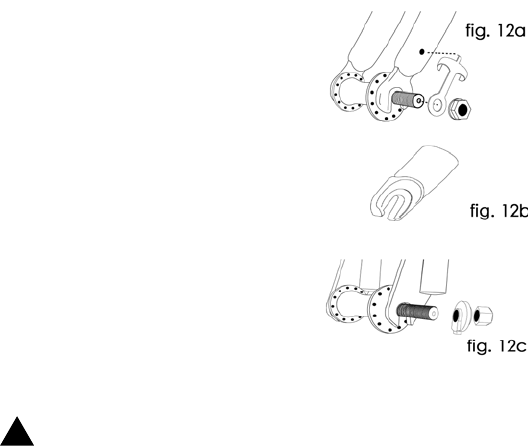
16
retention devices are not a substitute
for correct wheel clamping.
Secondary retention devices fall
into three basic categories (see gs.
12a, b & c):
a. The clip-on type is a part
which the manufacturer adds to
the front wheel hub or front fork
(g. 12a).
b. The integral type is molded,
cast or machined into the outer
faces of the front fork dropouts
(g. 12b).
c. The washer type is a hat-
shaped washer which fits into a
matching hole in the front fork
dropout (g. 12c).
Ask your dealer to explain the particular secondary
retention device on your bike.
!
WARNING: Removing or disabling the secondary retention
device is extremely dangerous and may lead to serious injury
or death. It also may void the warranty.
NOTE: Some bicycles are equipped with a lever action
quick release wheel retention mechanism. If your bicycle
has quick release wheels, see Appendix C for information
on how they work.
2. Removing a Bolt-On Front Wheel
a. If your bicycle has a front wheel hand brake with
quick release, open up the brake shoes (see Section
4.A.2.a. above).
b. With a correctly sized socket, box, open-end or
When you apply the brake(s), the bike begins to slow,
but your body wants to continue at the speed at which it
was going. This causes a transfer of weight to the front wheel
(or, under heavy braking with hand brakes, around the front
wheel hub, which could send you ying over the handlebars).
A wheel with more weight on it will accept greater brake
pressure before lockup; a wheel with less weight will lock up
with less brake pressure. So, as you apply brakes and your
weight shifts forward, you need to shift your body toward
the rear of the bike, to transfer weight back on to the rear
wheel. With hand brakes, you can further improve brake
performance by simultaneously decreasing rear braking
and increasing front braking force. Shifting weight to the rear
wheel is even more important on steep descents, because
descents shift weight forward.
The keys to effective speed control and safe stopping are
controlling wheel lockup and weight transfer. Practice braking
and weight transfer techniques where there is no trafc or other
hazards and distractions.
Everything changes when you ride on loose surfaces or
in wet weather. Tire adhesion is reduced, so the wheels have
less cornering and braking traction and can lock up with less
brake force. Moisture or dirt on the brake shoes of hand brakes
reduces their ability to grip. The way to maintain control on
loose or wet surfaces is to go more slowly to begin with.
B. Wheels
1. Front Wheel Secondary Retention Devices
Most bicycles have front forks which utilize a secondary
wheel retention device to keep the wheel from disengaging
if its clamping mechanism is incorrectly adjusted. Secondary


















